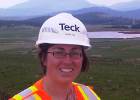Playing an important role

Michelle Unger, an environmental scientist with Teck, does remediation work at the Sullivan Mine site in Kimberley, B.C. — Ryan Peterson photo Michel
Michelle Unger, an environmental scientist with Teck, does remediation work at the Sullivan Mine site in Kimberley, B.C. — Ryan Peterson photo
Michelle Unger is Teck's environmental scientist in Kimberley; she is responsible for dormant properties. Her position involves implementing and managing environmental field studies related to the decommissioning, assessment and remediation of Teck’s closed metal mine sites.
Upon graduation from Royal Roads University in Victoria, B.C,, Unger worked for an Alberta consultancy. Then in 1998, she and her husband moved to the Kootenays in southeastern B.C., succumbing to the draw of the mountains.
For the next 12 years she worked with an environmental consulting company in Cranbrook, doing soil and groundwater environmental assessments in the Kootenay region.
“The company’s focus was assessments of commercial and industrial properties, including railyards, gas stations and mine sites,” said Unger, "including the Sullivan Mine in Kimberley."
In 2010, Unger moved on to work for Teck directly at the Sullivan Mine.
“I started my time in the Kootenay region collecting soil and water samples at the Sullivan Mine prior to its closure in 2001,” said Unger. “I am still involved 11 years after closure, and I am proud to have played a role in the successful closure of the Sullivan.”
The Sullivan Mine's life was more than 100 years from discovery to closure in 2001. Mining of the lead and zinc deposit, discovered in 1892, began in 1909. The mine reserves were 150 million tonnes of ore—including lead, zinc and iron—and during the life span of the mine, it produced 25.8 million tonnes of concentrates, 9.8 million tonnes of waste rock and 122 million tonnes of tailings. Fertilizer, steel and iron operations were subsidiary processes of the mine, and iron calcine—a cement additive—and phosphogypsum were mine residuals.
Reclamation planning began in 1972, with objectives to provide adequate soil to sustain vegetation, reduce water infiltration into the tailings and prevent upward migration of contaminants from the tailings into vegetation. Land reclamation, beginning in 1990, was completed by 2007. Post-reclamation management continues at the Sullivan site.
Unger said this involves a variety of activities, including water collection and treatment from the underground mine as well as groundwater interception areas, tailing dam maintenance and safety, and management of the underground mine facilities. Water monitoring and reclamation monitoring (for vegetation growth, uptake of metals and wildlife establishmen) continues.
Unger's job is not limited to the reclamation management of the Sullivan Mine. She also manages the legacy issues of other properties owned by Teck.
“Our group in Kimberley manages 22 properties, with half of them in British Columbia.,” said Unger.
She said one of the major reclamation projects is the Pinchi Lake Mine, located on the north shore of Pinchi Lake about 25 kilometres from Fort St. James, B.C.
“We have been working on this project for the last two years,” said Unger. “It was shut down in the '70s and all the infrastructure was left in place, so we decommissioned over the past two years, and we are doing a full reclamation.”
There was 15 years of environmental investigations to determine a proper closure strategy, Unger said.
“We have worked closely with the First Nations community to develop a sound remediation plan,” she added.
Unger said that when she became part of the project, she ensured the implementation of the plan with the construction manager and made sure environmental permits were met.
“It is likely that we will always have that property and will be monitoring it over the long term,” she said.
Unger considers herself fortunate to be in the position she is in. She is proud to be involved in the Sullivan Mine management and reclamation.
“It’s an international showcase site,” she said. “We have had many tour groups through here to see an example of a reclamation such as this.”
Unger said that when she moved to the area 12 years ago, she wasn't sure she would stay, but now, she said, being able to work in Kimberley is a dream come true.
“I feel very lucky to have been able to develop my environmental career here and enjoy the mountain lifestyle," she said. "It is really the best of both worlds.”



